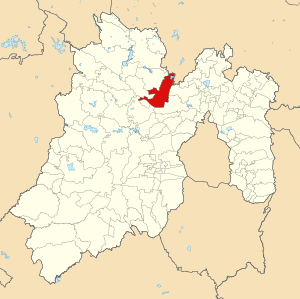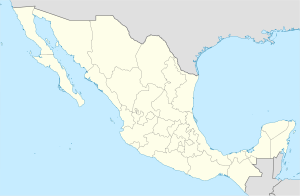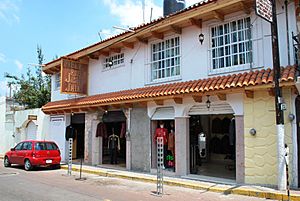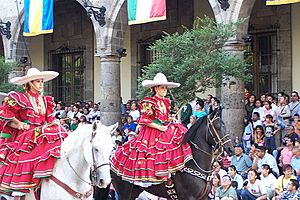Villa del Carbón facts for kids
Quick facts for kids
Villa del Carbón
|
|
|---|---|
|
Municipality
|
|

Temple of Nuestra Señora Santa María de la Peña de Francia
|
|
 |
|
| Country | |
| State | State of Mexico |
| Municipal Seat | Villa del Carbón |
| Town Founded | 1714 |
| Municipality Created | 1821 |
| Area
Municipality
|
|
| • Municipality | 356.14 km2 (137.51 sq mi) |
| Elevation
(of seat)
|
2,600 m (8,500 ft) |
| Population
(2005) Municipality
|
|
| • Municipality | 39,587 |
| • Seat | 8,029 |
| Time zone | UTC-6 (Central (US Central)) |
| • Summer (DST) | UTC-5 (Central) |
| Postal code (of seat) |
54300
|
| Area code(s) | 588 |
| Website | site |
Villa del Carbón is a special area in the northern part of Mexico State. It is located northwest of Mexico City. The main town, also called Villa del Carbón, is the biggest in the area. However, it is not the oldest community. This area has many villages with roots from the Otomí and Nahua cultures. These cultures are still very much alive today.
The area became a defined municipality in 1714. Back then, the main town didn't have an official name. It was first known by its church, Nuestra Señora de la Peña de Francia. Later, it became famous for making a lot of charcoal. This led to its long name, Villanueva del Carbón de Nuestra Señora Santa María de la Peña de Francia. Luckily, this name was shortened to Villa del Carbón. The symbol for the municipality (its coat-of-arms) shows two of its oldest villages: Taxhimay and San Lorenzo Pueblo Nuevo.
The municipality covers about 356 square kilometers. In 2005, it had a total population of 39,587 people. About 8,029 people live in the main town of Villa del Carbón. The rest live in 57 other communities that look to the main town for government services. Today, Villa del Carbón's economy mainly relies on tourism. It has many rivers and dams perfect for water sports, fishing, and camping. It is also home to a famous charreada (a type of rodeo) arena.
Contents
Exploring the Main Town of Villa del Carbón
The town of Villa del Carbón is located in the middle of the municipality. It sits high up, about 2,600 meters (8,530 feet) above sea level. In 2005, about 8,029 people lived here. Most buildings in town have white walls and sloped roofs made of Spanish-style clay tiles. The streets in the town center are made of cobblestones, giving it an old-world feel.
The Historic Church of Nuestra Señora de la Peña de Francia
The main church in town is called the Temple of Nuestra Señora de la Peña de Francia. It was built between 1700 and 1740. This church is why the town started here. It was built to hold a special statue of the Virgin Mary called "La Virgen de la Peña de Francia." This statue is one of only two brought to Mexico from Spain. The people living around the church were known as "those who make charcoal." This is how the town got its name. The Virgin statue is black, like charcoal, and many miracles were believed to happen because of her. For a long time, people hid the statue so authorities wouldn't take it. Today, you can see it clearly on the main altar. The church's design is typical for the early 1700s. In 1904, Crispín Montiel painted Bible scenes on the church's dome. The large trees around the church are as old as the municipality itself. Next to the church is the Luisa Isabel Campos de Jiménez Cantú Municipal Park. It has an outdoor Greek-style theater surrounded by tall pine trees.
Plaza Hidalgo: The Town's Central Square
Across from the church is the main town square, Plaza Hidalgo. It was built and named in 1906 to get ready for Mexico's 100th anniversary of Independence. The small building in the center, called a kiosk, used to be where the town's fountain was. This fountain provided drinking water for everyone. Now, the kiosk has the tourist information center. The plaza was updated in the 1960s and 1970s. That's when the palm trees and huge eucalyptus trees you see today were planted.
Casa de Cultura: A Hub for Learning
Besides the church, the plaza is surrounded by old and new government buildings. Many homes with shops on the ground floor also line the square. The old government building is now the Casa de Cultura Dr. Jorge Jiménez Cantú. This building was first built in the late 1600s in a Neoclassical style. By 1926, it was too old and had to be torn down. A new two-story building was built and opened in 1931. This center now has the municipality's library, an auditorium, and a place for people to continue their education.
Villa del Carbón: A Magical Town
Because of its traditional buildings and beautiful scenery, Villa del Carbón was chosen for the "Pueblos con Encanto" (Towns with Charm) program in the State of Mexico. The town has worked hard to promote itself this way. It also joined the "Pueblos con Encanto Bicentenario" program before Mexico's 200th Independence anniversary in 2010. In September 2015, the town was also added to the national "Pueblos Mágicos" (Magical Towns) program.
Exploring Other Communities in the Municipality
While the town of Villa del Carbón is the largest, it is not the oldest community in the municipality. The oldest villages are Cachihuapan, Taxhimay, Temanacoya, and Zacapexco. Zacapexco is west of the main town. It is so old that it is mentioned in the Huamantla Codex, a document from the 1500s or 1600s. It talks about Otomí groups moving from a cave in Chiapan to Zacatepexco Hill. The name Zacatepexco comes from Nahuatl and means "where there is a straw bed."
Another ancient village is Taxhimay, located north of the main town. Its name comes from Otomí and means "pasture of white sheep." This is because it is one of the few areas in the municipality with large grassy fields for animals.
The Taxhimay Dam and San Luis de las Peras
North of Taxhimay village is the Taxhimay Hacienda, a large estate. In 1931, the Taxhimay Dam was built nearby. This dam flooded the small village of San Luis de las Peras. Only the church tower and part of its dome can still be seen above the water. The hacienda provided land for the villagers to resettle.
Ancient Roots: Otomí and Nahua Villages
The oldest communities in this municipality have Otomí or Nahua origins. The Otomí people arrived first. Their most important villages include Taxhimay, Piequexhimó, and San Lorenzo Pueblo Nuevo. Later, Nahua villages like Cachihuapan, San Luis Anáhuac, Temanacoya, and Xajay were established. Both groups of communities still keep many of their cultural traditions alive. There's a story that when the Spanish were "refounding" the villages of San Luis Taxhimay (Otomí) and San Luis Anáhuac (Nahua), they argued over which village would keep two saint statues. One statue was of Saint Louis, King of France, and the other was of Our Lord of Lament. The story says they settled the argument with a coin toss! San Luis Anáhuac got the first statue, and San Luis Taxhimay got the second.
Geography and Natural Features
The municipality of Villa del Carbón is in the northern part of Mexico State. It is northwest of Mexico City. Much of the area has rugged hills and mountains. The highest point is Cerro de la Bufa, which is 3,600 meters (11,811 feet) high. These mountains connect to the Sierra de Tepotzotlán in the east. This mountain range is known as the Sierra de Monte Alto. These mountains are covered in pine and fir forests, making up 58% of the municipality. Rolling hills with drier land cover 34% of the area. Only about 9% is flat land, found in small, separate spots.
Climate and Weather
Because of its high altitude (between 2,300 and 3,600 meters), the municipality has a mild climate. Freezing temperatures are common in winter. The high areas are wet, while the lower hills can be quite dry. Strong winds blow across much of the municipality.
Waterways and Dams
The high elevations get a lot of rain. This creates many small freshwater springs. These springs form small streams that eventually join into the municipality's four rivers: the San Jeronimo, Las Animas, Los Sabios, and El Oro. There is also a "Río Seco" (Dry River) that only flows during the rainy season. Most of the larger bodies of water here are artificial lakes created by dams. These include the El Llano, Taxhimay, Benito Juárez, and Molinitos Dams. There is only one natural lake, called Santa Catarina.
A Look at Villa del Carbón's History
Early human life in the Villa del Carbón area is shown by cave paintings near the San Jeronimo River. The first people known to live here were the Otomí. They called this area "Nñonthe," meaning "top of the hill." We know they were here early because of old pottery and small human and animal figures found. Other nomadic groups joined the Otomí. Over time, their languages and stories mixed. This area became known as the Otomí region of Chiapan. This region is roughly where Villa del Carbón and Chapa de Mota are today.
This area was important in the ancient Mesoamerican world. It was located where traders traveled between Tula and Teotihuacan. This led to the building of forts and other structures. You can still find remains of these today, like the forts at Cañada and Taxhimay. There's also a ceremonial mound at El Mogote and very old, ruined buildings called Iglesias Viejas (Old Churches). The oldest communities that still exist are Otomí in character. This is because the Otomí liked rugged areas, unlike their neighbors, the Mazahuas and Matlatzincas. So, the Otomí controlled this area until about the 12th century. Later, Nahua people came and settled. By the 1400s, the Aztecs (a Nahua group) controlled this area, making the Otomí pay taxes to them.
Spanish Arrival and the Name "Villa del Carbón"
This changed with the Spanish Conquest of the Aztec Empire in the early 1500s. In the late 1500s, Spanish families started renting land from local chiefs. They used the land to raise cattle and sheep. More Spanish people moved to the area and married local people. For most of the time Mexico was a Spanish colony, the Chiapan area stayed together until 1714. In 1714, the area was split into what are now the municipalities of Chapa de Mota and Villa del Carbón.
At that time, the community that is now the main town was only known by its church, the "Congregation of Santa María de la Peña de Francia." Later, during the colonial period, the community also became known for supplying a lot of charcoal to nearby towns and even Mexico City. This activity gave it the long name: "Villa Nueva del Carbón de nuestra Señora Santa María de la Peña de Francia" (New Village of Charcoal of Our Lady of Holy Mary of the Hill of France). This also led to many local stories. To find the community, people would say "the New Village, where they make charcoal." Eventually, maps just marked it as "El Carbón," and people shortened the phrase to Villa del Carbón.
Independence and Early Challenges
When the Mexican War of Independence began in 1810, Villa del Carbón did not immediately join Miguel Hidalgo's fight. Support came after Hidalgo won the nearby Battle of Monte de las Cruces in 1810. After that, many people from here joined Hidalgo's army. A notable person from the main town was José Manuel Correa, who fought in important battles.
In the years right after Independence, this municipality faced problems because the government was unstable. There was a lot of crime, especially highway robbery. The rugged land here was perfect for bandits to hide and attack travelers. Finally, in 1834, President Antonio López de Santa Anna sent forces to fight the bandits. These forces fought the bandits at their forts around Villa del Carbón and defeated them in five days. The church bells of Villa del Carbón rang in celebration.
Later Historical Events
Another important event happened in 1861 when Melchor Ocampo, a famous Mexican politician, was brought to Villa del Carbón as a prisoner. He was held at the Los Fresnos House before being moved and later executed. During the French Intervention in 1863, Villa del Carbón supported Emperor Maximilian. A regiment (a group of soldiers) from here fought for the emperor. The main town was later burned in 1863.
During the Mexican Revolution, the town had problems with the Liberation Army of the South, like telegraph lines being cut. In 1931, the town got electricity and its first highway, connecting it to San Martín Cachihuapan. In the same year, the new municipal palace, town square, and municipal park were built. The clock in the municipal palace was installed in 1943.
Economy and Fun Activities
Tourism: Nature and Adventure
Tourism is the main way people in Villa del Carbón make money. This is thanks to its beautiful natural surroundings. Many small streams from freshwater springs flow into four rivers in the area. These rivers were dammed in the early 1900s, first for farming. But now, they are a big draw for tourists, especially for ecotourism. There are four main dams that attract visitors: Taxhimay, El Llano, Molinitos, and Benito Juárez.
These dams offer many activities like mountain biking, hiking, rappelling (climbing down ropes), swimming, jet skiing, kayaking, canoeing, sailing, and sport fishing, especially for trout. You can stay overnight in tents, RV camping facilities, or rustic cabins.
Taxhimay Dam: A Submerged Village
The largest and most important dam for the economy is the Taxhimay Dam. It was built in 1934. When it was built, it flooded the valley and covered the small community of San Luís de las Peras. Only the church tower and part of its dome are still visible above the water. You can take canoe tours to see the tower and dome up close. Besides the activities mentioned, the Taxhimay Dam also hosts the yearly XTERRA Triathlon.
El Llano Dam: A State Park Getaway
The El Llano Dam is about 20 kilometers (12 miles) from the town of Villa del Carbón. It is located inside a state park, which is also part of the Zacapexco ejido (community land). This area has a cool climate and the dam is surrounded by thick pine and fir forests. This area hosts the "Extremetour" event, organized by Raid Mexico [1]. There's also a cabin big enough for twenty people to stay in.
Smaller Dams: Benito Juárez and Molinitos
Two smaller dams, Benito Juárez and Molinitos, are still mainly used for farming. However, they also offer many activities, just on a smaller scale.
Trout Fishing and Farming
Trout has become a very important part of the local economy. The many rivers and streams that feed into the dams create great places for trout fishing and trout farming. At places like the Taxhimay Dam, you can rent a boat to fish. They even offer to cook what you catch! Trout farms raise and sell fish to places inside and outside Villa del Carbón. There are also many restaurants that specialize in dishes made with trout and other forest products. These restaurants are mostly found where rivers run near the highways leading to Mexico City and Atlacomulco.
Charreada: A Mexican Rodeo Tradition
In and around the main town, charreada (Mexican rodeo) is a big part of the local culture. Competitions here have become famous across the country. The main group that supports these events is the Villa del Carbón Charreada Association. This association has become very important in the charreada world. They now host national-level competitions at the Lienzo Charro Cornielio Nieto, just outside the town.
One special group to note is the Escaramuza Charra. This is a team of twelve women who perform amazing choreographed horse riding displays. This group has placed in the top three in many regional and national competitions. They even placed fifth in the national championships in 2005! The main charreada events in Villa del Carbón happen on March 10 (the municipality's founding day), September 16 (Mexican Independence Day), and December 8 (the feast day of Villa del Carbón's patron saint). On these days, the charreada events are joined by music, dances, craft shows, and local food.
Handcrafts: Leather and More
Since ranches and charreadas are a big part of Villa del Carbón's history, crafts related to them are very popular. Especially leather-making and leather products. The main items made are boots, leather jackets, hats, and other things horse riders need. Making these crafts provides jobs for many people in the municipality.
The most important item made here is called "botines." These are a type of ankle-high boot worn in charreada. Villa del Carbón is one of the last places in Mexico that still makes a lot of these boots, and they are sold all over the country. Another craft practiced here is making knitted items like scarves, ponchos, wraps, and sweaters. You can usually find these at the tianguis (a temporary market) that pops up on weekends at Plaza Hidalgo in the town center. Finally, the town also has several producers of "rompope," which is a sweet egg liqueur. Rompope was brought to Mexico by Spanish friars (religious brothers). Its production here started in the monasteries they built. But over time, regular people started making it.
See also
 In Spanish: Municipio de Villa del Carbón para niños
In Spanish: Municipio de Villa del Carbón para niños





